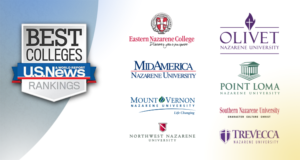Each year, college rankings come out in U.S. News & World Report’s “America’s Best Colleges“. What you may not know, however, is that these college rankings have been the subject of great controversy. Why?
Ranking Factors
Numerous scholars and college administrators have criticized the system used by U.S. News & World Report to determine college rankings. Here is a quick overview of how they come up with these rankings. The magazine rates colleges on seven different metrics:
1. Undergraduate Academic Reputation
In this category, schools are ranked primarily on how peers assess their reputation and, secondarily, on how high school counselors rate the school’s reputation. This category accounts for 22.5% of the weight in the final rankings.
2. Student Selectivity
Selectivity accounts for 15% of each college’s ranking. It takes into account the college’s overall acceptance rate, high school class rankings of incoming students, and SAT and ACT scores.
3. Faculty Resources
This metric looks at pay, degrees, number of faculty that is full-time, and class size. It accounts for 20% of each school’s overall score.
4. Graduation and Retention Rates
This category tallies the number of freshmen that return for sophomore year and also looks at graduation rates. It accounts for 20% of the overall college ranking.
5. Financial Resources
This category measures how much financial aid is provided and makes up 10% of the final score.
6. Alumni Giving
This category offers a look at the number of alumni who give money to the school and accounts for 5% of the overall score.
7. Graduation Rate Performance
This category measures the difference between the actual graduation rate and the predicted graduation rate over a six-year period. They derive the predicted graduation rate through a calculation that takes into account test scores and number of students receiving Pell grants. This accounts for 7.5% of a school’s overall score.
What is wrong with how these rankings work?
Generally speaking, many argue that the survey questions that U.S. News & World Report don’t necessarily equate to the educational quality of a college.
- In particular, state schools tend to get penalized by the way the rankings are done. Public universities tend to have larger class sizes and this lowers their overall ranking. As a professor at a large state school, however, I can attest to the fact that there are many opportunities for finding small classes.
- The second way that public schools are penalized in their rankings is because they tend to have lower and slower graduation rates. This is not surprising, given that many, many students enrolled in public universities work while going to school and this slows down their time to graduate.
- A final way that public universities are hurt by the ranking methodology is that these schools tend to have fewer full-time faculty than private schools. It is important to bear in mind, however, that just because a school has more full-time faculty, it does not mean that those faculty actually teach the courses. Many schools rely heavily on graduate student assistants to teach undergraduates. Moreover, this category assumes that only the full-time faculty can be strong instructors.
The other problem with the rankings is that they create hysteria over the top schools. Because so many parents and kids get obsessed with the rankings, they tend to focus on only the highest-ranked colleges. As a result, those colleges receive insane numbers of applications, which, in turn, bolsters their rankings.
Over 76% of students are accepted by their first-choice college.
Source: The American Freshman: National Norms for Fall 2015
Those are really good odds.
So keep that in mind as you develop your list of colleges. Because people become so obsessed with the brand-name schools, they miss the reality about getting into college.

